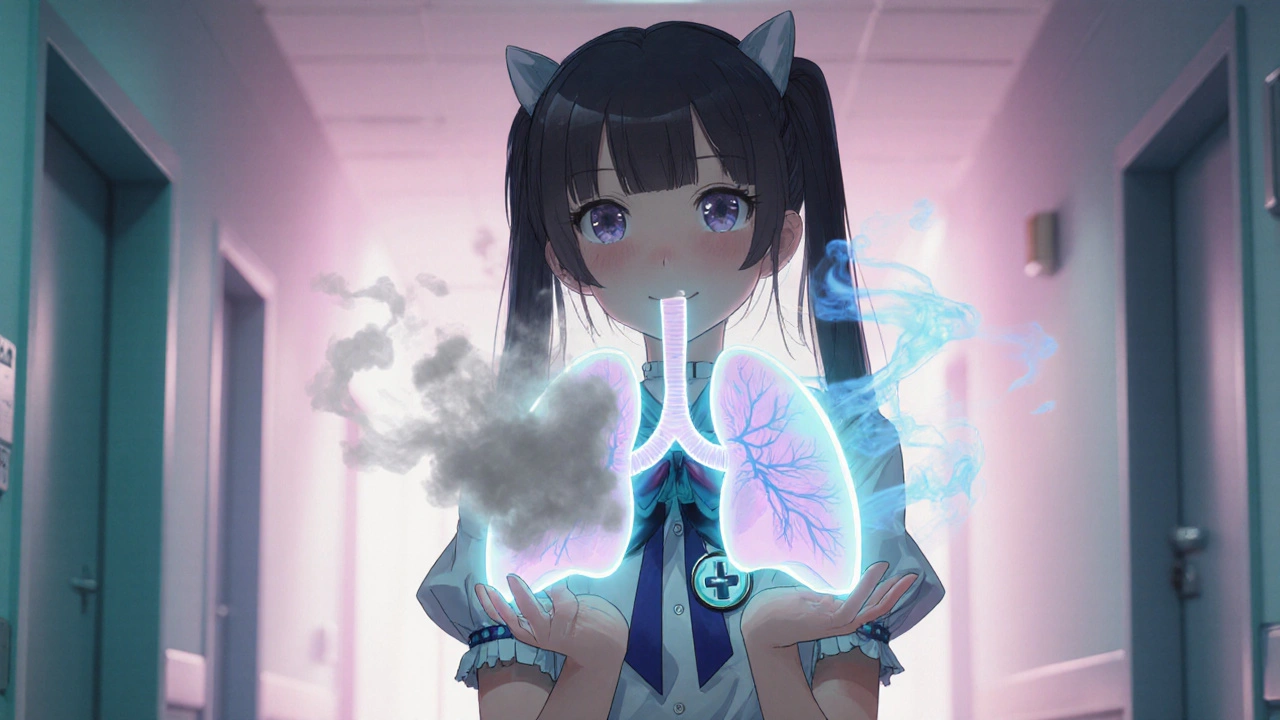COPD Anxiety Symptom Checker
This tool helps identify anxiety symptoms specifically related to COPD. Based on the article's guidance, answer the following questions using the 0-5 scale (0 = none, 5 = severe).
Did you know that people living with chronic lung problems are up to twice as likely to develop an anxiety disorder? The relationship between COPD and anxiety isn’t a coincidence - it’s a two‑way street where breathing trouble fuels worry, and worry makes breathing even harder.
What is Obstructive Pulmonary Disease?
Chronic Obstructive Pulmonary Disease (COPD) is a progressive lung condition that blocks airflow and makes it difficult to exhale fully. Typical causes include long‑term smoking, exposure to air pollutants, and genetic factors like alpha‑1 antitrypsin deficiency. Symptoms such as persistent cough, sputum production, and especially dyspnea (shortness of breath) worsen over time.
What are Anxiety Disorders?
Anxiety Disorders comprise a group of mental‑health conditions characterized by excessive fear, worry, and physiological arousal that interfere with daily life. Common forms include generalized anxiety disorder (GAD), panic disorder, and social anxiety disorder. Physical signs often mirror those of lung disease: rapid heartbeat, shortness of breath, and muscle tension.
Why Do the Two Conditions Meet?
Both illnesses share several overlapping triggers. When COPD restricts airflow, the brain receives signals of low oxygen (hypoxia) and high carbon dioxide levels, which activate the fight‑or‑flight response. This response releases cortisol and adrenaline, hormones that heighten anxiety. In turn, anxiety amplifies breathing irregularities, creating a feedback loop that can spiral quickly.
Biological Mechanisms that Bridge the Gap
- Inflammation is a hallmark of COPD, and chronic systemic inflammation also influences neurotransmitter balance, raising anxiety risk.
- Hypoxia reduces oxygen supply to the brain, impairing emotional regulation and making panic attacks more likely.
- Corticosteroids used for COPD flare‑ups can, at high doses, trigger mood swings, insomnia, and anxious thoughts.

Lifestyle Factors that Compound Stress
Smoking remains the leading preventable cause of COPD, and nicotine itself is a stimulant that fuels anxiety. Physical inactivity, often forced by breathlessness, reduces endorphin release and weakens the mental benefits of exercise. Social isolation - a common result of limited mobility - removes vital emotional support.
Spotting Anxiety in Someone with COPD
Early detection makes a huge difference. Look for these red‑flags:
- Persistent worry about breathlessness, even when lung function is stable.
- Avoidance of activities that once were routine (e.g., walking to the mailbox).
- Sleep disturbances caused by nighttime coughing or racing thoughts.
- Physical signs such as trembling, sweating, or a rapid heart rate unrelated to exertion.
Screening tools like the Hospital Anxiety and Depression Scale (HADS) or the GAD‑7 questionnaire are quick, validated ways to gauge anxiety severity.
Managing Both Conditions Together
Integrated care is the gold standard. Here’s a practical toolbox:
- Pulmonary Rehabilitation combines exercise training, education, and breathing techniques, which lower breathlessness‑related anxiety.
- Cognitive Behavioral Therapy (CBT) helps reframe catastrophic thoughts about breathing and teaches coping strategies.
- Mindful breathing exercises (e.g., pursed‑lip breathing) reduce hyperventilation and calm the nervous system.
- Medications: Low‑dose antidepressants (SSRIs) are safe for most COPD patients and can blunt anxiety spikes.
- Quit‑smoking programs: Removing the nicotine trigger cuts both lung damage and anxiety spikes.

Quick Reference Table
| Factor | Impact on COPD | Impact on Anxiety |
|---|---|---|
| Dyspnea | Limits activity, worsens disease progression | Triggers panic, fuels chronic worry |
| Systemic Inflammation | Accelerates airway narrowing | Alters neurotransmitter balance |
| Hypoxia | Reduces exercise tolerance | Impaired emotional regulation |
| Corticosteroid Use | Controls flare‑ups | May cause mood swings, insomnia |
| Smoking | Primary cause of lung damage | Nicotine stimulates anxiety pathways |
Practical Tips for Daily Life
- Schedule short, frequent walks; even 5‑minute bouts improve oxygenation and mood.
- Keep a breathing diary: note situations that spike breathlessness and the thoughts that follow.
- Use a peak‑flow meter or spirometer at home to gain objective data, which calms catastrophizing.
- Join a support group-online or local-to share coping strategies and break isolation.
- Talk to your healthcare team about adjusting inhaler timing to cover anxiety‑inducing events (e.g., public speaking).
Frequently Asked Questions
Can anxiety make COPD symptoms worse?
Yes. Anxiety raises heart rate and breathing frequency, which can intensify dyspnea and create a perception of worsening lung function.
Are antidepressants safe for people with COPD?
Most SSRIs have a clean respiratory profile and are often prescribed when anxiety interferes with COPD management. Always discuss dosage with your doctor.
How do I know if my shortness of breath is anxiety or a COPD flare?
A flare‑up usually comes with increased sputum, wheeze, or fever. Anxiety‑driven breathlessness often appears during stressful thoughts and improves with calming techniques.
What breathing exercises work best for anxiety‑related dyspnea?
Pursed‑lip breathing and diaphragmatic breathing are simple, evidence‑based methods that reduce airway pressure and calm the nervous system.
Is pulmonary rehabilitation covered by insurance for mental‑health benefits?
Many health plans include pulmonary rehab as a chronic‑disease service, and its mental‑health benefits are recognized in recent guidelines. Check with your insurer for specific coverage details.





kendra mukhia
Honestly, anyone who thinks COPD and anxiety are just random coincidences is missing the whole point. The two-way street they describe is a textbook example of how physiological stress spirals into psychological distress. When your lungs can't give you enough oxygen, your brain lights up the alarm system, flooding you with cortisol and adrenaline. That hormonal surge is exactly what fuels the feeling of dread and panic. Then, of course, the anxiety makes your breathing muscles tense, which only worsens the dyspnea. It’s a vicious feedback loop that clinicians need to break before patients spiral out of control.
Bethany Torkelson
Stop pretending this isn’t obvious – you get short breathing, you get panic, end of story! That’s why we need to treat both sides at the same time.
Grace Hada
Cut the fluff, anxiety is a direct physiological response to hypoxia; ignore it and you’re just delaying inevitable collapse.
alex montana
Whoa!!! The breath‑triggered panic rise… – it's like a rollercoaster??! But hey… you can actually… calm it… with paced breathing…
Wyatt Schwindt
I get that it’s tough, but remember simple breathing exercises can really lower that anxiety spike.
Avril Harrison
From a cultural viewpoint, many folks just shrug off anxiety because it’s not talked about in their community, which makes the whole COPD‑anxiety combo even trickier.
Sarah Hanson
Indeed, the integration of pulmonary rehab and mental health services is paramount – its effect on patient outcomes cannot be overstated. I wholeheartedly agre on this point, though note that misspellings happen in real‑world notes.
Nhasala Joshi
Did you ever consider that the pharma‑industry might be using COPD‑anxiety research to push new “miracle” meds? 🤔💊 The data is conveniently framed to keep us dependent. 🌫️🧠
Brian Van Horne
One must appreciate the nuanced interplay of physiological stressors and the mental state; employing a lexicon of vibrant metaphor enriches our comprehension of such comorbidities.